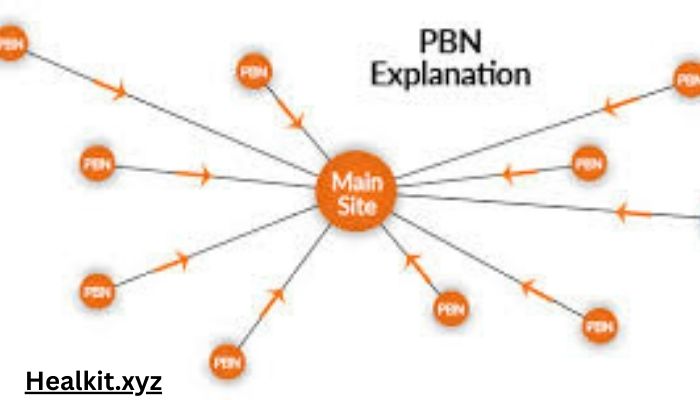A Private Blog Network (PBN) refers to a group of websites all under the ownership of one individual. These websites solely link back to the owner’s main website, thus enhancing its search engine ranking. PBNs are commonly employed by website owners operating within industries where traditional link-building methods are scarce. In such cases, PBNs offer a viable solution for acquiring backlinks. The individual websites within a PBN are often called satellites, forming a network to bolster the main website’s online presence.
How does PBN work?
Private Blog Networks (PBNs) are structured to connect each domain to a central website. While PBNs may be beneficial in some areas, they may only be somewhat effective. The effectiveness of your PBN strategy depends on your approach. If your PBN contains expired domains, you should expect average results. Similarly, neglecting to create attractive content and increase your link profile will likely not increase your essential website’s visibility in Google search rankings. Constantly optimizing your PBN and prioritizing quality content creation is crucial to achieving the best results and maintaining search engine compliance.
What makes PBNs more effective than white hat links?
No matter how unique your content is, promoting it effectively on various platforms is crucial to increasing its visibility by gaining interest from the general public or industry experts and securing shares. Giving becomes difficult with the staggering volume of content produced daily, all vying for the same audience’s attention; it’s easy to get lost in your content exchange. Additionally, relying solely on organic SEO for conversions often yields disappointing results. Private Blog Networks (PBNs) offer a solution by giving you complete control over crucial SEO components like anchor text and links. By leveraging PBNs, you can quickly increase your website’s ranking, attracting more traffic and generating leads faster.
TYPES OF PBNS
Quality PBNs
Creating high-quality private blog networks (PBNs) involves crafting websites from scratch, whether by generating original content or curating it from various sources. Interestingly, platforms where individuals regularly engage with news updates or seek information could serve as clandestine networks, resembling primary websites in functionality. The advantage of such PBNs lies in their legitimacy and alignment with search engine algorithms, minimizing the risk of being penalized by Google.
By mirroring your main website’s content, you enhance the potential for back linking, thereby accelerating your site’s ranking process. Furthermore, you retain complete control over keyword selection and density, allowing for strategic optimization. Flexibility is another key benefit, as backlinks can be adjusted promptly in response to Google’s algorithm updates. As a result, these meticulously crafted PBNs boast longevity, requiring minimal alterations over time to maintain efficacy.
Non-Quality PBNs
Despite its misleading name, non-quality PBNs are not necessarily low in value. These PBNs consist of a network of websites boasting high Domain Authority (DA), Domain Rating (DR), and PageRank (PR) scores, albeit lacking in website traffic. They are high-scoring sites crafted primarily for SEO purposes, yet they attract minimal genuine visitors. This scarcity of organic traffic often stems from the need for ranked keywords on search results pages directing users to these sites. Despite needing more SEO quality, non-quality PBNs are usually perceived as a shortcut to achieving rapid results in search engine rankings.
Engaging in this type of PBN strategy entails the procurement of expired domains with pre-existing backlinks, allowing for immediate content alteration and optimization for SEO purposes. This approach presents the opportunity for accelerated website ranking compared to conventional methods. Moreover, streamlined time management is a notable advantage, primarily involving content updates and backlink generation tailored to desired keywords across multiple websites. Additionally, the cost-effectiveness of non-quality PBNs is evident, as acquiring expired domains with favorable scores tends to be relatively inexpensive, and the operational demands are minimal due to the modest content update requirements.
How to Identify PBNs?
To uncover potential links between websites, you can use several strategies:
- Consider checking the hosting details using tools like SpyOnWeb.com, which can reveal whether multiple sites are hosted on the same server, suggesting a possible connection
- Exploring. the source code of websites can provide valuable insights, especially in the case of WordPress themes where the theme name is often embedded. Consistency in theme usage across multiple sites may indicate a private blog network (PBN).
- It may be enlightening to examine the use of images and videos.
Sites may reuse existing media rather than create their own, making tools like Google Image Search or Video Search invaluable for identifying similarities. Examining the backlink profiles of these sites using tools like Ahrefs or Majestic can unveil linking patterns, another hallmark of a PBN. Duplicate content is another red flag. Tools like Grammarly or Copyscape can help detect copied paragraphs across multiple sites. Also, pay attention to the logo; Low-quality or text-based logos can suggest minimal effort or a lack of proper branding. Traffic analysis is essential; legitimate sites usually collect organic keywords and traffic, so if a site is lacking in these metrics, it warrants further investigation using tools like Ahrefs, SEMrush, or Moz.
Checking the WHOIS database can shed light on on-site ownership. Hidden information or multiple sites sharing the same owner can indicate interconnected blogs. Finally, observe the site’s design elements, such as navigation, color schemes, and overall layout. Uniformity across multiple sites may indicate a coordinated effort or network. By employing these techniques, you can better identify potential relationships between websites and identify instances of manipulation or fraud. Read More
